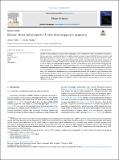Por favor, use este identificador para citar o enlazar a este item:
http://hdl.handle.net/10261/337326COMPARTIR / EXPORTAR:
 SHARE
BASE SHARE
BASE
|
|
| Visualizar otros formatos: MARC | Dublin Core | RDF | ORE | MODS | METS | DIDL | DATACITE | |

| Título: | Review: Status and prospects of association mapping in grapevine |
Autor: | Tello, Javier CSIC ORCID ; Ibáñez Marcos, Javier CSIC ORCID | Palabras clave: | Breeding Genetic diversity GWAS QTL Vitis vinifera L |
Fecha de publicación: | feb-2023 | Editor: | Elsevier | Citación: | Plant Science 327: 111539 (2023) | Resumen: | Thanks to current advances in sequencing technologies, novel bioinformatics tools, and efficient modeling solutions, association mapping has become a widely accepted approach to unravel the link between genotype and phenotype diversity in numerous crops. In grapevine, this strategy has been used in the last decades to understand the genetic basis of traits of agronomic interest (fruit quality, crop yield, biotic and abiotic resistance), of special relevance nowadays to improve crop resilience to cope with future climate scenarios. Genome-wide association studies have identified many putative causative loci for different traits, some of them overlapping well-known causal genes identified by conventional quantitative trait loci studies in biparental progenies, and/or validated by functional approaches. In addition, candidate-gene association studies have been useful to pinpoint the causal mutation underlying phenotypic variation for several traits of high interest in breeding programs (like berry color, seedlessness, and muscat flavor), information that has been used to develop highly informative and useful markers already in use in marker-assisted selection processes. Thus, association mapping has proved to represent a valuable step towards high quality and sustainable grape production. This review summarizes current applications of association mapping in grapevine research and discusses future prospects in view of current viticulture challenges. | Versión del editor: | http://dx.doi.org/10.1016/j.plantsci.2022.111539 | URI: | http://hdl.handle.net/10261/337326 | DOI: | 10.1016/j.plantsci.2022.111539 | Identificadores: | doi: 10.1016/j.plantsci.2022.111539 issn: 0168-9452 |
| Aparece en las colecciones: | (ICVV) Artículos |
Ficheros en este ítem:
| Fichero | Descripción | Tamaño | Formato | |
|---|---|---|---|---|
| 1-s2.0-S0168945222003648-main.pdf | 4,29 MB | Adobe PDF |  Visualizar/Abrir |
CORE Recommender
Page view(s)
29
checked on 22-may-2024
Download(s)
21
checked on 22-may-2024
Google ScholarTM
Check
Altmetric
Altmetric
Este item está licenciado bajo una Licencia Creative Commons

